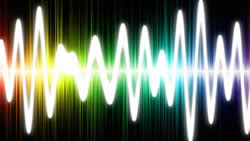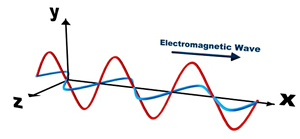Difference between Sound Waves and Electromagnetic Waves
Key Difference: Sound waves are commonly related to the travel of sound. Sound is technically defined as a mechanical disturbance traveling through an elastic medium. Sound is a mechanical vibration that passes through a medium such as gas, liquid or solid to become a sound. Electromagnetic wave, also known as EM wave, is the travel path of electromagnetic radiation or EMR. EMR is a form of energy that is emitted and absorbed by charged particles.
 Sound waves and electromagnetic waves are two different types of waves that are seen daily. Sound waves are responsible for the travel of sound using a medium, while electromagnetic waves are responsible for the travel of light or radio waves and is a result of changes in the electric and magnetic field. These waves are important in understanding concepts such as optics, waves and vibrations, electromagnetism, acoustics and many others. Let’s understand these two waves separately.
Sound waves and electromagnetic waves are two different types of waves that are seen daily. Sound waves are responsible for the travel of sound using a medium, while electromagnetic waves are responsible for the travel of light or radio waves and is a result of changes in the electric and magnetic field. These waves are important in understanding concepts such as optics, waves and vibrations, electromagnetism, acoustics and many others. Let’s understand these two waves separately.
Sound waves are commonly related to the travel of sound. Sound is technically defined as a mechanical disturbance traveling through an elastic medium. The medium is not limited to air but can also include wood, metal, stone, glass and water. Sound travels in waves, these are known as sound waves. The most common method of traveling includes the air. Similar to all matter, air is also made up of molecules. These molecules are constantly in motion and great speed. When they are in this speed, molecules tend to bump into each other causing transference of energy. Sound are said to travel in waves because when an object is struck (for example a drum), the drum head moves back and forth and pushes against the air in the same fashion. The push and pull of the air causes the sound to bump against other molecules in the air and transfer this energy, resulting in sound waves.
Sound travels in two types of waves: longitudinal and transverse waves. Longitudinal waves are waves whose direction of vibration is the same as their direction of travel. In layman’s terms the direction of the medium is the same or the opposite direction to the motion of the wave. Transverse wave is a moving wave that consist of oscillations perpendicular to the direction of the energy transfer; for example if a wave is moving in a vertical fashion, the energy transfer is moving in an horizontal fashion.
The properties of sound waves include: Frequency, Wavelength, Wavenumber, Amplitude, Sound pressure, Sound intensity, Speed of sound and Direction. The speed of sound is an important property that determines the speed at which sound travels. The speed of sound differs depending on the medium through which it travels. The greater the elasticity and the lower the density, the faster a sound travels. Because of this sound travels faster in solids compared to liquids and faster in liquids compared to gas.
According to How Stuff Works, “At 32 °F. (0 °C.), the speed of sound in air is 1,087 feet per second (331 m/s); at 68 °F. (20 °C.), it is 1,127 feet per second (343 m/s).” The wavelength of a sound is the distance the disturbance travels in one cycle and is related to the sound’s speed and frequency. High frequency sounds have shorter wavelengths and low frequency sounds having longer wavelengths.
 Electromagnetic waves, also known as EM waves is the travel path of electromagnetic radiation or EMR. EMR is a form of energy that is emitted and absorbed by charged particles. Electromagnetic waves include both magnetic and electric components that are in a fixed ratio of intensity to each other and oscillate in a phase perpendicular to each other and perpendicular to the direction of energy and wave propagation. Unlike sound and mechanical waves that require a medium for traveling, EM waves do not require any medium for traveling. In vacuum, electromagnetic radiation travels at the speed of light.
Electromagnetic waves, also known as EM waves is the travel path of electromagnetic radiation or EMR. EMR is a form of energy that is emitted and absorbed by charged particles. Electromagnetic waves include both magnetic and electric components that are in a fixed ratio of intensity to each other and oscillate in a phase perpendicular to each other and perpendicular to the direction of energy and wave propagation. Unlike sound and mechanical waves that require a medium for traveling, EM waves do not require any medium for traveling. In vacuum, electromagnetic radiation travels at the speed of light.
Electromagnetic waves were formally postulated by James Clerk Maxwell and were later confirmed by Heinrich Hertz. Maxwell predicted the wave like nature using electric and magnetic equations, which was later proved by Hertz in an experiment. According to Maxwell’s equations, a spatially varying electric field will also be associated with a magnetic field that changes over time. Similarly, a spatially varying magnetic field is associated with specific changes over time in the electric field. Maxwell also found in his equations that the speed of the wave was equal to the experimental value of speed of light; resulting in the theory that light is an electromagnetic wave.
Electromagnetic radiation travels in the form of transverse waves. As already stated transverse wave is a moving wave that consists of oscillations perpendicular to the direction of the energy transfer and travel. It was later on discovered that although EMR travels in waves, it travels in packets of waves. It was already previously established that EMR has energy, which is transferred from one molecule to another during traveling. This energy is consumed or exerted when energy shifts state. For example, when an electron shifts from one orbital level to another in an atom, it results in absorbing or exerting energy, depending on the shift. This energy that is absorbed or exerted is named as photon. Using multiple experiments, it has been proven that EMR exhibits both wave and particle-like properties, resulting in having wave-particle duality.
The major difference between sound waves and electromagnetic waves is that while sound waves require a medium to travel, electromagnetic waves do not. Sound waves also do carry energy when traveling, which is done by EM waves. While sound waves only act as waves, EM waves act as waves as well as particles. Another major difference is EM waves travel at the speed of light, which is much faster than the speed of sound.
Image Courtesy: mashable.com, astronomy.swin.edu.au









Add new comment